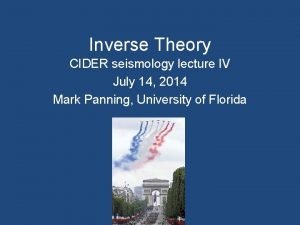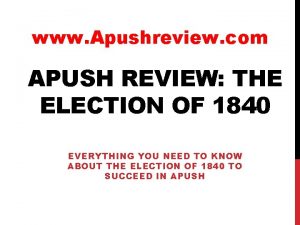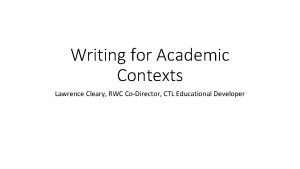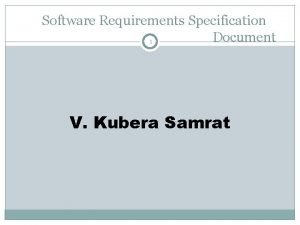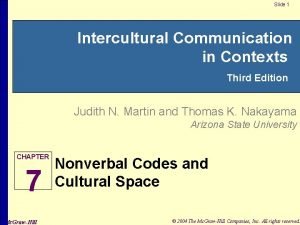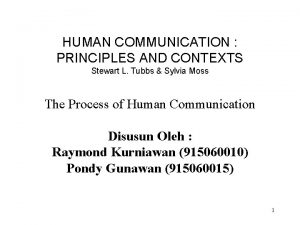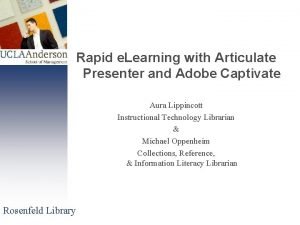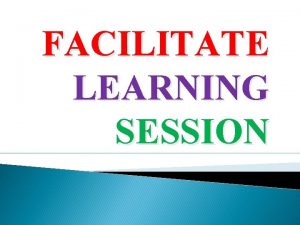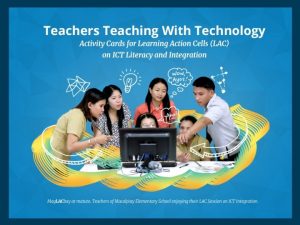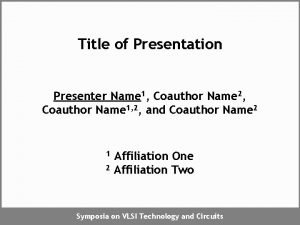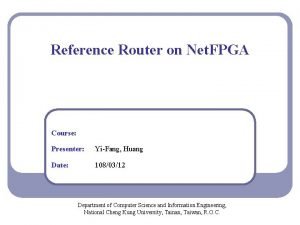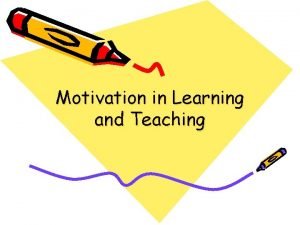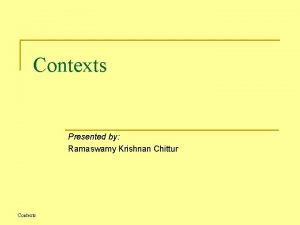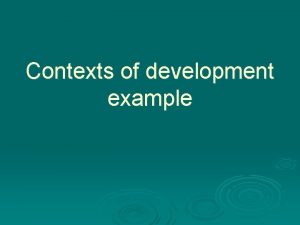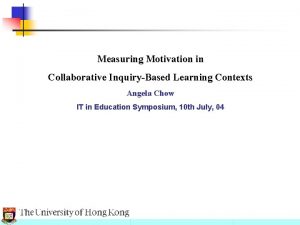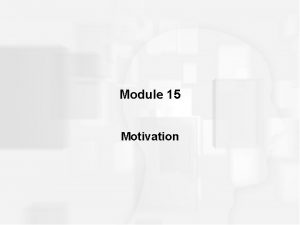CIDER SESSION MOTIVATION IN ONLINE LEARNING CONTEXTS Presenter




















- Slides: 20

CIDER SESSION MOTIVATION IN ONLINE LEARNING CONTEXTS Presenter: Dr. Maggie Hartnett m. hartnett@massey. ac. nz

So what is ….

is… “a theoretical construct used to explain the initiation, direction, intensity, persistence, and quality of behaviour , especially goaldirected behaviour” (Brophy, 2010, p. 3)

“…the concept of student motivation is used to explain the degree to which students invest attention and effort in various pursuits, which may or may not be the ones desired by their teachers. ” (Brophy, 2010, p. 3)

is inferred from types of behaviour … effort choices achievement persistence

2 different kinds of decisions… Can I do it? Do I want to? I think I can Images: Tom Curtis / Free. Digital. Photos. net

concepts can be broadly organised using the following model … Expectancy X Value I think I can = Motivation Images: Tom Curtis / Free. Digital. Photos. net

Research is relevant & timely … • • • rapid growth in online learning increasing diversification attrition rates limited research in online contexts lack of ‘situated’ view of motivation Instructional design Learner characteristics

Research Aims a) Explore the nature of motivation to learn of students in online distance learning environments b) Explore relationships between social and contextual factors and student motivation

Theoretical Framework • intrinsic – extrinsic motivation • Self-Determination Theory (SDT) (Ryan & Deci, 2000) • concepts of autonomy, autonomy competence and relatedness

Underlying concepts Autonomy - “the experience of choice in the initiation, maintenance and regulation of activity and the experience of connectedness between one’s actions and personal goals and values” (Connell, 1990, p. 62 -63) Competence - “the need to experience oneself as capable of producing desired outcomes and avoiding negative outcomes” (Connell & Wellborn, 1991, p. 51). Relatedness Relatednes – “encompasses the need to feel securely connected to the social surround and the need to experience oneself as worthy and capable of … respect” (Connell & Wellborn, 1991, pp. 51 -52)

Continuum of human motivation SIMS – likert-type scale Type of motivation Amotivation Intrinsic Motivation Extrinsic Motivation Type of Regulation Non. Regulation External Regulation Introjected Regulation Identified Regulation Integrated Regulation Intrinsic Regulation Associated processes Non-relevance Low competence Rewards/ punishment Approval from self/ others Utility value Congruence Interest/ enjoyment Quality of Behaviour Non-self-determined (Ryan & Deci, 2002, p. 16) Self-determined

Research Context New Zealand Higher Education University Primary pre-service teacher education programme Course 1 Semester one 2008 online distance cohort Problem based learning (PBL) assignment and associated activities Case Study 1 Course 2 Semester one 2008 online distance cohort Micro-teaching assignment & associated activities Case Study 2 Data collection methods • Interviews • Questionnaires • Archived online data • Achievement data • Course resources

Nature of motivation Amotivation Extrinsic Motivation External regulation Multi-dimensional : Intrinsic Motivation Identified regulation learners reported a range of motivation types to varying degrees Situation-dependent: significant differences between the two case studies Complex : the same features within the same environment supported motivation in some participants and undermined it in others.

Supportive influences Learning Activity Teacher Competence • • • ongoing guidance * supportive, formative feedback* responsive* • • Autonomy • • • promotes situational interest* provides meaningful choice * uses informational rather than controlling language Relatedness • • • friendly & caring* uses self-disclosure models inclusiveness & respect *Evident in both case studies Peers Competence clear guidelines & expectations* resources are relevant & useful* optimal challenge* builds on prior knowledge & experience Autonomy • • relevant & meaningful to the learner at a professional & personal level* active learning opportunities* opportunities to pursue topics personally interesting to learners* course content & the nature of the task is perceived as autonomy supportive Relatedness • (see teacher & peer factors) Competence • • helpful & supportive* encourage high collective efficacy among collaborative groups Autonomy • encourage significant role in group decisions & tasks by all members Relatedness • • friendly & caring* value contributions* respectful* inclusive

Undermining influences Learning Activity Teacher Competence • guidance & feedback perceived as insufficient Autonomy • uses course expectations & language that are perceived as controlling Relatedness • (see learning activity & peers) • • • Competence Peers guidelines unclear/complicated judgements of low self-efficacy resulting from insufficient prior task knowledge/ experience teacher input gradually reduced resource perceived as not useful challenge too great Competence Autonomy • • • high workload salience of marks lack of relevance time constraints* technology constraints* perceptions of limited choice* Relatedness *Evident in both case studies • limited opportunities for interactions in wider class • (see teacher & learning activity) Autonomy • • perceptions of limited input in group decisions & tasks perceptions of workload inequity Relatedness • communication issues & disagreements

Implications • Revise simplistic notions of motivation • Motivational needs of learners encompass control, competence and connection • social & contextual factors identified are starting point for considering motivation needs of online learners

Implications cont’d • teachers have an important motivational role to play - Highlight relevance & value of task - Offering meaningful choice - Alignment with personal goals and interests - Active & authentic learning opportunities that promote interest - Responsiveness • requires a differentiated approach - Guidance - Structure - Feedback - Language used (both written & verbal)

Questions? ?

References Connell, J. P. (1990). Context, self, and action: A motivational analysis of self-system processes across the life-span. In D. Cicchetti & M. Beeghly (Eds. ), The self in transition: Infancy to childhood (pp. 61 -98). Chicago: University of Chicago Press. Connell, J. P. , & Wellborn, J. G. (1991). Competence, autonomy and relatedness: A motivational analysis of self-system processes. In M. R. Gunnar & L. A. Sroufe (Eds. ), Self processes and development: The Minnesota symposia on child development (Vol. 23, pp. 43 -77). Hillsdale, NJ: Lawrence Erlbaum. Hartnett, M. (2010). Motivation to learn in online environments: An exploration of two tertiary education contexts (Doctoral thesis, Massey University, Palmerston North, New Zealand). Available from http: //muir. massey. ac. nz/handle/10179/2043 Hartnett, M. , St. George, A. , & Dron, J. (2011 a). Being together: Factors that unintentionally undermine motivation in co-located online learning environments. Journal of Open, Flexible and Distance Learning, 15(1), 1 -16. Retrieved from http: //journals. akoaotearoa. ac. nz/index. php/JOFDL/article/view/19 Hartnett, M. , St. George, A. , & Dron, J. (2011 b). Examining motivation in online distance learning environments: Complex, multifaceted and situation-dependent. The International Review of Research in Open and Distance Learning, 12(6), 20 -38. Retrieved from http: //www. irrodl. org/index. php/irrodl/article/view/1030 Ryan, R. M. , & Deci, E. L. (2000). Intrinsic and extrinsic motivations: Classic definitions and new directions. Contemporary Educational Psychology, 25(1), 54 -67. Ryan, R. M. , & Deci, E. L. (2002). Overview of Self-Determination theory: An organismic dialectical perspective. In E. L. Deci & R. M. Ryan (Eds. ), Handbook of self-determination research (pp. 3 -33). Rochester, NY: The University of Rochester Press.
 Gravity theory cider
Gravity theory cider Log cabin and hard cider campaign apush
Log cabin and hard cider campaign apush Professional context
Professional context Writing in academic contexts
Writing in academic contexts Teachers in crisis contexts
Teachers in crisis contexts The sociological perspective stresses that
The sociological perspective stresses that Bad srs document
Bad srs document Global context
Global context Intercultural communication in contexts
Intercultural communication in contexts Shape matching and object recognition using shape contexts
Shape matching and object recognition using shape contexts Human communication: principles and contexts
Human communication: principles and contexts Shape matching and object recognition using shape contexts
Shape matching and object recognition using shape contexts Adobe presenter demo
Adobe presenter demo Cuadro comparativo e-learning m-learning b-learning
Cuadro comparativo e-learning m-learning b-learning Facilitate learning session
Facilitate learning session Lac session template
Lac session template Motivation in ob
Motivation in ob Text presenter
Text presenter Presentation by name
Presentation by name Social media presenter
Social media presenter Presenter over net
Presenter over net
